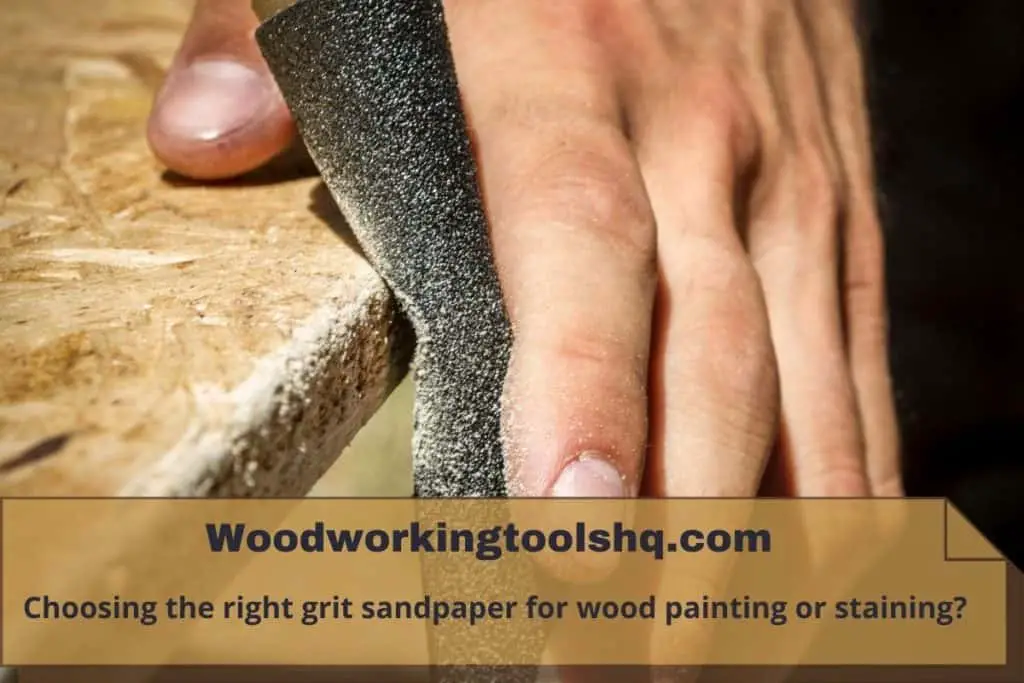There are some necessary things you should know regarding the type of sandpaper and which grit you should use.
As a wrong grit of sandpaper can probably damage your wood project if you use it to sand wood.
Which grit sandpaper should you use on wood?
It depends a lot on the lumber of wood you’re about to sand. And the purpose of sanding is also a factor to take into account.
With that said, if you need to sand a wood surface made out of hardwoods then you can choose a rough sandpaper 40 or 60 grits will work just fine to remove stubborn grains, already painted layer, stained, etc.
And in an attempt to prepare bare softwood lumber for painting or staining ideally, 180 grit or 220 will do the work just fine.
- When stripping or sanding heavily, use coarse sandpaper gritted from 40 to 60.
- Choose 80 to 120 grit sandpaper to smooth surfaces and remove small imperfections.
- For smoothing surfaces, use sandpaper with a grit between 360 and 400.
What does the grit number on sandpaper mean?
You have seen different numbers on and grit paper, even wondered what does that mean?
Let’s make it simple to understand.
Sandpaper grit is the number of particles that make up the surface.
80 grit sandpaper, for example, contains 80 abrasive particles per square inch.
Similarly, the 220 Gritsandpaper has 220 of these tiny particles per square inch.
Increasing the number will result in finer surfaces.
Not to mention that the lower number means the paper is rough and good to work for removing stubborn rust, paints, sains, while the higher number is ideal for sanding before painting on wood to get a nice and smooth finish.
How is sandpaper made?
In addition to the different grades and grits, sandpaper is also made from materials that are chemically reactive.
Most snappers are chemical compounds that are shaped like thin papers.
To hold the abrasive in place on the side where the particles are supposed to be attached, an adhesive is applied.
On the backside, which is used for applying force, the surface is kept dry.
Cotton, polyester, rayon, PET film, and rubber are some of the powerful adhesives that are typically used for this purpose.
Grit with extremely fine particles is backed with mylar.
Sandpaper grits for woods use chart
Sandpapers are classified mainly into two groups depending on their grit. Macro and Micro.
Below is the chart showing the grit and where to use them with a little guidance.
| Grade | Properties | Grit number | Applied to |
|---|---|---|---|
| Very Fine | Under micro-abrasives, this type of material is coarser than Very Fine | 150, 180 or 220 | This grit is used for Sanding on naked wood to remove grains and making it balanced. |
| Fine | Not suitable to remove stubborn varnish or paint from the wood. | 100 or 120 | This grit is used for cleaning plaster, preparing wood for finishing, and removing water stains |
| Medium | After sanding, the texture of the surface is medium to coarse | 80 | This grit is used for Wood that needs to be sanded before varnish can be stripped and final finishing can be applied |
| Coarse | Is capable of rapidly remove junk materials from lumber of wood. | 40, 50 or 60 | This grit is used for Removing a layer of debris or finish with the least amount of effort |
| Extra Coarse | The majority of materials can be removed quickly & easily | 24, 30 or 36 | This grit is used for Initial efforts in hardwood floor sanding |
what grit sandpaper for removing paint from wood?
Use 40-80 grit sandpaper and in the end-use 150 grit for a better result.
Depending upon the wood and the types of paint you can increase the number.
Start with anywhere from 40 grip sandpaper which is rough and can scratch the paint layer more effectively.
Then increase the number to 60 and 80 until the surface has no paint left over.
Finally, it’s recommended to rub with 150 grit sandpaper because most likely the 40-80 grits would not be able to completely pull off the paint.
A 150 grit has dense particles per square area which gets them done just right.
what grit sandpaper to remove stain from wood?
For stains, it’s best to use 100-grit sandpaper.
Getting stains out of wood is a difficult task because they don’t layer on the top instead go deep down into the wood.
So without the right use of grit size, you may hurt the wood.
Several types carry pigment on the surface, while others go deep into the pores.
With this in mind, sandpaper with a 40 grit rating can cause the wood to crack, so use something besides sandpaper that won’t damage the appearance of the wood.
For best results, use 100- or 120-grit sandpaper on wood lumber to remove the stain.
what sandpaper to use on wood before painting?
When it comes to sanding bare wood completely before painting so you the most out in the end, knowing the types of wood is critical.
For softwoods like pine, cherry, birch, or even maple can be sanded with a 150-grit. Then increase the number to 220-grit for a smoother finish.
For naked hardwoods, you should start with 100 or 120 grit sandpaper then gradually increase the number until you reach 220 grit.





